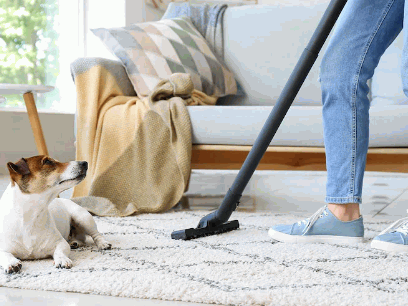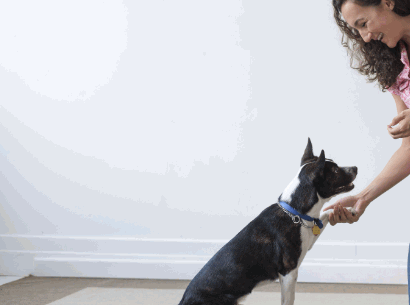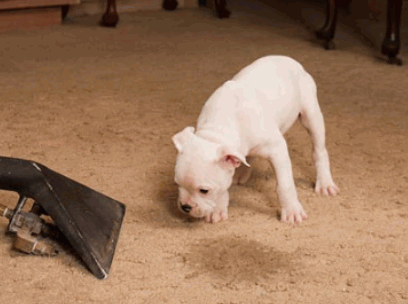Are you tired of constantly dealing with the unpleasant smell and stains of dog urine on your carpet? Look no further, as this article will provide you with simple and effective methods to completely remove dog urine from your carpet. Say goodbye to the frustration and embarrassment that comes with a smelly and stained carpet.

Why Is It Important To Clean Dog Urine From Carpet?
Cleaning dog urine from the carpet is crucial to prevent lingering odors, stains, and potential health hazards. Urine can seep into the carpet fibers, promoting bacterial growth and unpleasant smells that can be difficult to eliminate.
To effectively clean the area, begin by blotting with paper towels, then apply a pet stain remover and use a carpet cleaner. For a natural approach, consider using white vinegar or baking soda to neutralize odors.
Explore further: How To Clean A Bedroom Carpet

What Are The Steps To Clean Dog Urine From Carpet?
Dealing with dog urine on your carpet can be a frustrating and unpleasant experience. However, with the right techniques, you can effectively remove the stain and odor, leaving your carpet looking and smelling fresh again. In this section, we will discuss the four essential steps to successfully clean dog urine from your carpet. From quickly blotting the urine to using a homemade solution, we'll cover all the necessary methods to ensure a thorough and effective clean.
1. Blot The Urine Immediately
To effectively clean dog urine from the carpet, follow these steps promptly:
- Blot the urine immediately using paper towels or a clean cloth to absorb most of the liquid.
- Apply an enzyme-based cleaner to break down the urine's components and eliminate odor.
- Use a homemade solution of water and vinegar to further clean and deodorize the area.
- Rinse the area thoroughly with clean water to remove any remaining residue.
Fact: Immediate cleaning helps prevent deep penetration of urine, reducing long-term odor and stains.

2. Apply An Enzyme-based Cleaner
When using an enzyme-based cleaner to remove dog urine from the carpet, follow these steps:
- Blot the urine immediately to absorb most of the liquid.
- Apply the enzyme-based cleaner to break down the urine components and eliminate odor.
- Allow the cleaner to sit and work on the affected area for the specified duration.
- Rinse the area thoroughly with clean water to remove any remaining residue.
For best results, be sure to follow the manufacturer's instructions for the enzyme-based cleaner and test it on a small, inconspicuous area of the carpet first.

3. Use A Homemade Solution
To effectively clean dog urine from the carpet using a homemade solution, follow these simple steps:
- Mix equal parts of white vinegar and water in a spray bottle.
- Add a small amount of baking soda to the solution.
- Apply the mixture to the affected area and let it sit for 5-10 minutes.
- Blot the area dry with a clean cloth.
For optimal results, repeat the process if necessary and make sure the area is completely dry to prevent any lingering odors.

4. Rinse The Area Thoroughly
When rinsing the area thoroughly after cleaning dog urine from the carpet, follow these steps:
- Prepare a solution of warm water and a small amount of mild detergent.
- Apply the solution to the affected area and gently scrub with a soft brush.
- Rinse the area thoroughly with clean water using a sponge or cloth, making sure to remove all soapy residue.
- Blot the area with a dry cloth to absorb any excess moisture.
To prevent recurring stains, be sure to rinse the area thoroughly and allow it to completely dry to discourage pets from marking the area again.
What Are The Tips To Prevent Dog Urine Stains On Carpet?
No pet owner wants to deal with the hassle of cleaning dog urine stains from their carpet. That’s why it’s important to take preventative measures to avoid these accidents in the first place. In this section, we will discuss three essential tips for preventing dog urine stains on your carpet. From proper training techniques to using specialized repellents, these tips will help you keep your carpet clean and your furry friend happy.
1. Train Your Dog Properly
- Start training your dog properly from an early age to establish good habits.
- Use positive reinforcement techniques such as treats and praise to encourage desired behavior.
- Consistently reinforce training to ensure long-term success.
- Provide a designated bathroom area to reinforce appropriate elimination habits.

2. Provide Frequent Bathroom Breaks
- Establish a routine for taking your dog outside for bathroom breaks, ensuring they have plenty of opportunities to relieve themselves.
- Monitor your dog's behavior for signs of needing to urinate, such as sniffing or circling, and promptly take them outside.
- Consider using potty training aids or bell training to communicate when it's time for a bathroom break.
Providing frequent bathroom breaks for your dog is crucial for maintaining a clean carpet and promoting their overall well-being. Consistent training and attentiveness can help prevent indoor accidents and preserve the cleanliness of your home.
3. Use A Dog Urine Repellent
- Choose a dog urine repellent that contains natural ingredients, such as lemon or vinegar-based solutions.
- Apply the repellent in areas where your dog has previously soiled to discourage repeated accidents.
- Reapply the repellent regularly, particularly after cleaning the area, to strengthen the aversion to urinating in the same spot.

What Are The Possible Side Effects Of Not Cleaning Dog Urine From Carpet?
As pet owners, we know that accidents happen and our beloved furry friends may leave their mark on our carpets. But beyond the visible mess, what are the potential consequences of not properly cleaning dog urine from our carpets? In this section, we will discuss the possible side effects that can result from neglecting to clean up after our pets. From unpleasant odors to bacterial growth, we will uncover the importance of properly addressing dog urine on our carpets.
1. Strong Odor
- Identify the source: Locate the affected area and assess the intensity of the strong odor.
- Blot the area: Use paper towels to absorb as much urine as possible to minimize the strong odor.
- Apply enzymatic cleaner: Utilize an enzyme-based cleaner to break down the uric acid compounds causing the strong smell.
- Avoid ammonia-based cleaners: Refrain from using ammonia-based cleaners as they can exacerbate the strong odor.
- Allow drying: Ensure the area dries completely to prevent the return of the strong odor.
2. Attracts More Urine
- Unremoved dog urine can attract more urine due to the scent-marking nature of dogs.
- This behavior is particularly common if the urine odor is still detectable after cleaning.
- To prevent repeat incidents, thoroughly clean and deodorize the affected area to eliminate any lingering scent that may attract more urine.
3. Causes Stains And Discoloration
- Dog urine contains uric acid which can react with carpets, causing unpleasant stains and discoloration over time.
- The acidity of the urine can also break down carpet dyes, leading to visible discoloration.
- If left untreated, the urine can penetrate deep into the carpet fibers, making stain removal more challenging and causing stains and discoloration.
4. Promotes Bacterial Growth
Neglecting to clean dog urine from the carpet can result in various issues, including strong odor, attracting more urine, stains, and discoloration. Moreover, it promotes the growth of bacteria, which can pose health risks to those living in the environment.
To prevent these effects, it is important to promptly clean dog urine using enzyme-based cleaners and consider professional carpet cleaning for older stains. It is also beneficial to encourage proper training and provide frequent bathroom breaks for your dog to maintain a clean and hygienic living environment.
How To Remove Old Dog Urine Stains From Carpet?
Dealing with old dog urine stains on your carpet can be a frustrating and unpleasant task. However, with the right approach, it is possible to effectively remove these stubborn stains and eliminate any lingering odors. In this section, we will discuss the best methods for removing old dog urine stains from carpets. From using an enzyme-based cleaner to renting a steam cleaner or hiring a professional, we will cover all the options to help you find the best solution for your specific situation.

1. Soak The Stain With Enzyme-based Cleaner
- Blot the area with a clean cloth to absorb excess urine.
- Apply an enzyme-based cleaner to soak the stain and break down the urine odor.
- Allow the cleaner to sit for the recommended time as per the product instructions.
- Blot the area again to remove the cleaner and residual urine.
- Allow the carpet to air dry thoroughly.
In 2015, a study found that enzyme-based cleaners were the most effective in removing dog urine stains from carpets, validating their widespread use in pet care.
2. Use A Steam Cleaner
- Prepare the area: Remove furniture and debris to ensure the steam cleaner covers the entire stained area.
- Fill the cleaner: Follow the manufacturer's instructions to add water and any recommended cleaning solution.
- Operate the steam cleaner: Move the machine over the stained area, allowing the steam and suction to remove the urine and cleaning solution.
- Dry the carpet: Ventilate the room and use fans to help the carpet dry completely.
The concept of using steam for cleaning dates back to ancient times when the Greeks used steam to clean their bodies in bathhouses, recognizing its cleansing power.

3. Hire A Professional Carpet Cleaner
In 1997, a professional carpet cleaner set a Guinness World Record for cleaning the largest carpet in the world, measuring over 60,000 square feet at a trade show in Las Vegas.
- Research and hire a local professional carpet cleaner with a proven track record.
- Read customer reviews and ask for recommendations from others for a reliable service.
- Obtain quotes from multiple cleaners to compare pricing and services offered.
- Verify the cleaner's credentials, insurance, and guarantees for the work.
- Schedule a consultation to discuss the scope of the job and address any specific concerns.
